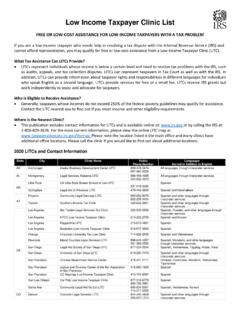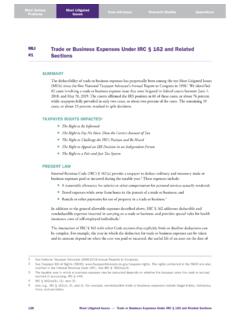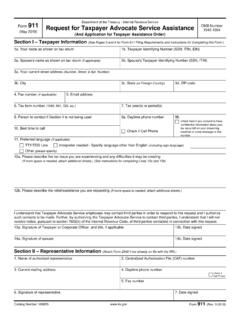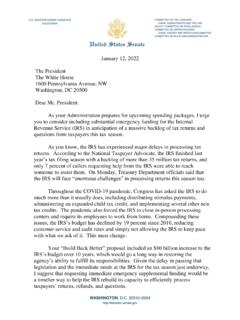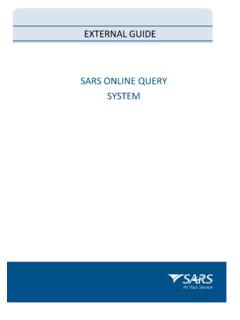Transcription of National Taxpayer Advocate ANNUAL REPORT TO CONGRESS
1 ANNUAL REPORT TO CONGRESSN ational Taxpayer Summary Prologue & HighlightsTable of ContentsiAnnual REPORT to CONGRESS 2021 Executive SummaryTABLE OF CONTENTSPROLOGUE1. Preface: Introductory Remarks by the National Taxpayer Advocate ..12. Taxpayer Rights and Service Assessment: IRS Performance Measures and Data Relating to Taxpayer Rights and Most Serious Problems At a Glance ..204. Highlights of TAS Successes Throughout the Past Year ..235. Data Compilation and Validation ..31 THE MOST SERIOUS PROBLEMS ENCOUNTERED BY TAXPAYERS PROCESSING AND REFUND DELAYS: Excessive Processing and Refund Delays Harm IRS RECRUITMENT, HIRING, AND TRAINING: The Lack of Sufficient and Highly Trained Employees Impedes Effective Tax Administration ..353. TELEPHONE AND IN-PERSON SERVICE: Taxpayers Face Significant Challenges Reaching IRS Representatives Due to Longstanding Deficiencies and Pandemic Complications ..374. TRANSPARENCY AND CLARITY: The IRS Lacks Proactive Transparency and Fails To Provide Timely, Accurate, and Clear Information.
2 385. FILING SEASON DELAYS: Millions of Taxpayers Experienced Difficulties and Challenges in the 2021 Filing Season ..396. ONLINE ACCOUNTS: IRS Online Accounts Do Not Have Sufficient Functionality and Integration With Existing Tools to Meet the Needs of Taxpayers and DIGITAL COMMUNICATIONS: Digital Communication Tools Are Too Limited, Making Communication With the IRS Unnecessarily E-FILING BARRIERS: Electronic Filing Barriers Increase Taxpayer Burden, Cause Processing Delays, and Waste IRS CORRESPONDENCE AUDITS: Low-Income Taxpayers Encounter Communication Barriers That Hinder Audit Resolution, Leading to Increased Burdens and Downstream Consequences for Taxpayers, the IRS, TAS, and the Tax Court ..4510. COLLECTION: IRS Collection Policies and Procedures Negatively Impact Low-Income LITIGATED ISSUES ..49 National Taxpayer Advocate 2022 PURPLE BOOK: Compilation of Legislative Recommendations to Strengthen Taxpayer Rights and Improve Tax page intentionally left Advocate ServiceiiPrologue: PrefacePrologue1 ANNUAL REPORT to CONGRESS 2021 Executive SummaryPROLOGUEP reface: Introductory Remarks by the National Taxpayer AdvocateHONORABLE MEMBERS OF CONGRESS :Each year, the National Taxpayer Advocate has the privilege of submitting her ANNUAL REPORT to CONGRESS .
3 I respectfully submit this year s REPORT for your consideration and welcome the opportunity to discuss it in more detail. Section 7803(c)(2)(B)(ii) of the IRC requires the National Taxpayer Advocate to submit an ANNUAL REPORT to the House Committee on Ways and Means and the Senate Committee on Finance that, among other things, includes a summary of the ten most serious problems encountered by taxpayers and makes administrative and legislative recommendations to mitigate those problems. In each of the ten Most Serious Problem discussions, we are including an IRS narrative response. By doing so, we intend to help readers see both TAS s perspective and the IRS s perspective on the source and nature of key challenges and potential solutions. Although the ANNUAL REPORT focuses on the ten Most Serious Problems, I view my role as requiring continual efforts to improve Taxpayer service and tax administration by working collaboratively with the IRS throughout the year on both newly identified problems and longstanding The statute also requires the REPORT to identify the ten federal tax issues most frequently litigated in court.
4 This year, we took a hybrid approach to that discussion, reviewing decided cases and for the first time, analyzing issues raised in filed petitions with the Tax Court. This analysis provides a broader perspective on Taxpayer problems that are not initially solved at the administrative level. The year 2021 provided no shortage of Taxpayer problems. As I stated in my Fiscal Year 2022 Objectives REPORT , this past year and the 2021 filing season conjure up every possible clich for taxpayers, tax professionals, the IRS, and its employees it was a perfect storm; it was the best of times and the worst of times; patience is a virtue; with experience comes wisdom and with wisdom comes experience; out of the ashes we rise; and we experienced historical highs and lows. Calendar year 2021 was surely the most challenging year taxpayers and tax professionals have ever experienced long processing and refund delays, difficulty reaching the IRS by phone, correspondence that went unprocessed for many months, collection notices issued while Taxpayer correspondence was awaiting processing, limited or no information on the Where s My Refund?
5 Tool for delayed returns, and for full disclosure difficulty obtaining timely assistance from TAS. The IRS Deserves Credit for Playing the Hand It Was DealtOne irony of the past year is that, despite its challenges, the IRS performed well under the circumstances. The imbalance between the IRS s workload and its resources has never been greater. On the workload side, the number of individual taxpayers the IRS serves has increased by about 19 percent since 2010, as the number of Form 1040 series returns rose from about 142 million in that year to about 169 million in While there is no perfect measure of the IRS s workload, return filings are a good approximation because most IRS work including fraud screening, telephone calls, audits, collection actions, TAS cases, Appeals cases, Tax Court cases, and other downstream consequences keys off the number of taxpayers filing returns. During the last 18 months, CONGRESS charged the IRS with administering several COVID-19 pandemic financial relief programs, including three rounds of stimulus payments (also known as Economic Impact Payments), monthly payments of the Advance Child Tax Credit (AdvCTC), reduction of the taxability of unemployment compensation in the middle of the 2021 filing season, and other provisions directly impacting tax administration.
6 Each financial relief program consumed considerable IRS resources to administer, including overall planning, information technology (IT) programming, implementation, public communications, and responding to taxpayers questions and account issues. To address these needs, the IRS had to reallocate resources from its core tax administration responsibilities. Prologue: PrefacePrologueTaxpayer Advocate Service2 Over the last decade, examination coverage has decreased, enforcement efforts have been negatively impacted, and the Level of Service has continued to drop as the IRS s workforce and budget have declined. On the resources side, the IRS s baseline budget has been reduced by about 20 percent on an inflation-adjusted basis since fiscal year (FY) 2010, and its workforce has shrunk by about 17 Although CONGRESS provided supplemental funding to help the IRS implement pandemic-relief programs, it is not feasible for an agency the size of the IRS to staff up and train new employees quickly.
7 The IRS also is limited in its ability to hire new employees when funding is provided on a one-time basis because there is no assurance it will have sufficient funding in future years to retain those employees. In addition, the social distancing required during the pandemic forced the agency to close or limit staffing in processing centers where employees work in close quarters, further restricting its production its limitations, the IRS processed most e-filed tax returns timely, it issued 130 million refunds totaling $365 billion,4 it issued 478 million stimulus payments totaling $812 billion,5 and it sent AdvCTC payments to over 36 million families that totaled over $93 The IRS s leadership and workforce deserve considerable credit for their 2021 Was the Most Challenging Year Ever for Taxpayers There is no way to sugarcoat the year 2021 in tax administration: From the perspective of tens of millions of taxpayers, it was horrendous. Among the lowlights: Processing Backlogs Led to Long Refund Delays.
8 The IRS was behind before the 2021 filing season had even started because it carried over approximately million returns from 2020. It took until June 2021 before the IRS had processed virtually all 2019 returns. Then, in 2021, the IRS received approximately 17 million original Form 1040 series returns on Paper returns have been taking up to at least eight months to In addition, the IRS closed the filing season with million individual returns in its Error Resolution System (ERS) that required manual processing for each return. Millions of additional returns were worked in ERS at other points during the year. The IRS also issued over 11 million math error notices relating to Recovery Rebate Credit (RRC) claims, and in many cases, refunds were not released until taxpayers responded in writing, potentially delaying refunds by many , 77 percent of individual taxpayers received refunds in 2021,9 so processing delays translated directly into refund delays.
9 Refund delays have a disproportionate impact on low-income taxpayers. (Earned Income Tax Credit (EITC) benefits are worth up to $6,660, Child Tax Credit benefits are worth up to $2,000 per qualifying child under tax year 2020 rules, and RRCs are potentially worth several thousand dollars for families who did not receive advance payments.) Millions of taxpayers rely on the benefits from these programs to pay their basic living expenses, and when refunds are substantially delayed, the financial impact can range from mild inconvenience to severe financial hardship. For taxpayers who filed an amended return, the processing (and refund) delays have been even longer than the delays for original paper returns. As of December 18, 2021, the IRS reported it had a backlog of million unprocessed Forms 1040-X, Amended Individual Income Tax Return, and that processing times can be more than 20 weeks instead of up to 16. 10 We have seen cases where processing has taken considerably longer than 20 weeks, including more than a year.
10 The manual reviews will take substantial time, preventing the IRS from digging out of that hole in the foreseeable returns have also been subject to processing delays. At the close of the filing season, the IRS reported more than seven million business returns that required manual processing. Delays in processing Forms 941, Employer s Quarterly Federal Tax Return, and Forms 941-X, Adjusted Employer s Quarterly Federal Tax Return or Claim for Refund, have been significant. As of December 15, the IRS reported it had million unprocessed Forms 941 and about 427,000 Forms 941-X that cannot be processed until the related Forms 941 are : PrefacePrologue3 ANNUAL REPORT to CONGRESS 2021 Executive SummaryFor individuals, estates, or trusts that file Form 1045, Application for a Tentative Refund, or corporations that file Form 1139, Corporation Application for a Tentative Refund, relating to the carryback of net operating losses, the IRS is not even providing information on refund wait times.
